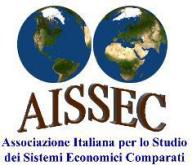by Augusto Ninni - Mercatorum University, Rome
1) The Context of the Energy Transition Crisis
The crisis surrounding the energy transition did not begin with the especially negative arrival of Donald Trump as President of the United States. In Europe, the Russia–Ukraine war, which began in February 2022, highlighted for individual countries both the convenience and the necessity of reducing dependence on Russian natural gas, while forcing them to do so urgently. This urgency allowed for replacement with renewable sources—a key component of the energy transition—only in terms of upstream electricity generation. However, the process of replacing gas with electricity in final energy consumption was much more limited. According to Enerdata, in 2024 only 21% of final energy consumption was met by electricity, a share only slightly lower than in 2020.
In Europe, the energy transition has faced resistance not only from industries linked to fossil fuels but from those directly affected by the transition—such as the automotive sector—as well as from households. For this reason, the President of the European Commission, Ursula von der Leyen, was compelled to temper her ambition of strengthening the industrial competitiveness of the EU-27 by aligning it with the energy transition. This adjustment was evident in her two State of the Union addresses, marking a shift from the Green Industrial Deal of December 2019 to the Clean Industrial Deal of December 2024.
Notice that in Western countries, renewable energy production has also been curiously hindered by local opposition to the installation of new solar and, in particular, wind power facilities. The reasons for opposition vary, but the defense of the landscape is the most frequently cited justification.
2) The Trump Administration and Its Impact
The return of Donald Trump to the presidency has further exacerbated the situation. Upon taking office on January 20, 2025, he:
Immediately withdrew the United States from the 2015 Paris Agreement;
- Extensively promoted electricity generation from fossil fuels;
- Terminated U.S. participation in several international public financing initiatives supporting the energy transition in emerging countries;
- Repealed the Inflation Reduction Act—previously the most comprehensive public financing initiative for the energy transition in Western nations—replacing it with the Big Beautiful Bill;
- Declared open hostility toward wind energy, most notably by blocking the nearly completed Revolution Wind offshore project, thereby causing serious financial difficulties for Ørsted, a leading Danish renewable energy firm;
- Signed an agreement with Ursula von der Leyen under which the European Union committed to importing $750 billion worth of energy (primarily LNG) from the United States by 2028—a plan widely regarded as unfeasible on both the European demand and U.S. supply sides, and inherently contradictory to the aims of the energy transition.
Moreover, shortly after Trump’s election victory—but before he officially took office—six major U.S. banks (JP Morgan, Citigroup, Bank of America, Morgan Stanley, Wells Fargo, and Goldman Sachs) withdrew from the Net Zero Banking Alliance (NZBA), an initiative aimed at channeling private savings into renewable energy projects in developing countries.
Given the repositioning in energy supply in the United States—and more broadly in Western countries—toward directions inconsistent with the goals of the energy transition, an essential question arises: can the transition, conceived as a “global common good,” still be achieved through the actions of emerging economies, even if over a longer time horizon than previously considered acceptable?
Scarica il volume in open access
Gli anni duemila non sono stati anni facili. Negli anni 2000-2024 l’economia mondiale è stata scossa da numerosi fenomeni geo-politici come il terrorismo, le guerre, le grandi migrazioni; da gravi fenomeni ambientali quali il riscaldamento globale e la riduzione della bio-diversità; da grandi shock di natura finanziaria; da pandemie globali, quali il Covid 19. Ciò fa pensare che senza la fusione nel crogiuolo rovente della storia è difficile fare buona economia politica. L’economia concorre a forgiare la storia, ma spesso gli eventi storici influenzano grandemente le tendenze economiche. Nonostante gravi atti teroristici e guerre, fino al 2007 l’economia mondiale, trainata dall’ ascesa di grandi economie emergenti quali la Cina e l’India, è riuscita in media a crescere ad un ritmo discreto, ma dalla grande crisi finanziaria del 2008-9 in poi l’andamento è stato nettamente più debole e incerto.
Il libro si concentra soprattutto sulle maggiori economie dell’Europa e del resto del mondo che più influenzano gli andamenti globali.
Inizia quindi da un’analisi del livello e delle variazioni nel tempo del potere economico globale delle maggiori economie, misurato dalle loro dimensioni economiche, dal potere militare, tecnologico e finanziario, dalle diseguaglianze economiche e sociali e dai livelli di coesione sociale. All’interno dei paesi e anche a livello globale vi è stata inoltre la crescente influenza sul sistema politico di molti grandi ricchi e delle loro imprese che hanno contribuito a erodere la democrazia in diversi paesi, nonché la complessa e non sempre limpida interazione fra leader politici e grandi ricchi in non pochi regimi autocratici. Il libro prosegue nel secondo capitolo con l’analisi del le relazioni fra grandi shock, quali i mutamenti ambientali, il terrorismo e le guerre, la grande crisi finanziaria, la pandemia Covid -19, con le tendenze profonde dell’economia mondiale e gli andamenti della globalizzazione.
Il terzo e quarto capitolo sono dedicati rispettivamente all’economia dell’Europa e a quello delle altre maggiori economie del mondo.
Si analizzano nei due capitoli il progressivo appassimento demografico, economico, e tecnologico dell’Europa e, al suo interno, dell’Unione Europea e delle sue principali economie, Italia inclusa; la lenta riduzione dell’egemonia economica della grande potenza americana a fronte dell’ascesa di Cina e India e di alcune grandi e medie economie mondiali; i contrastanti problemi economici del mondo islamico; il persistere di estese forme di povertà in molti paesi del mondo.
Una delle principali conclusioni del volume è che, se non si combatteranno con sufficiente vigore e tenacia le tendenze nazionalistiche e suprematiste, le diseguaglianze economiche e sociali e la crisi ambientale, il mondo non potrà essere in pace e l’Unione Europea non riuscirà ad arrestare il proprio declino economico, demografico e tecnologico.
Maurizio Bussolo - The World Bank[1]
Abstract[2]
This short paper discusses the evolving perspectives on economic inequality over the past decade and examines potential future developments in this field of research. Initially, economic inequality was mainly analyzed through the perspectives of market efficiency and individual responsibility. Economists predominantly highlighted the role of free markets in fostering growth and prosperity, often overlooking distributional issues. However, a notable shift has occurred in the economic discourse on inequality, and the focus has increasingly turned towards inclusive growth, and the fact that high inequality can undermine economic and social progress. In the last decade, four primary themes have been explored and the new research has intensified this shift: (i) the assessment of levels and trends of inequality of outcomes and inequality of opportunities, (ii) the multifaceted impacts of inequality, (iii) global inequality, and (iv) the political economy of inequality. Future research trajectories will be shaped by interdisciplinary collaboration, technological advances, and the exigent challenges posed by climate change and global disruptions.
1. Introduction: some recent influential work on inequality
Economic inequality, defined as the unequal distribution of income and wealth among individuals and groups within a society, has been a persistent issue throughout history. In the recent decade, the study of economic inequality has gained renewed importance, as economists and policymakers recognize its far-reaching implications for social and economic progress. In his 2013 State of the Union address, President Barack Obama emphasized that while the economy was recovering, the benefits were not being evenly distributed. He stated that “Inequality is the defining challenge of our time.” This note explores the evolving perspectives on economic inequality over the past decade and examines potential developments for the next decade.
Initially, economic inequality was often viewed through the lens of market efficiency and individual responsibility. Traditional economic theories emphasized the role of free markets in promoting growth and prosperity, with less attention given to the distributional outcomes. A significant shift in the way economists approach the issue of economic inequality has intensified in the past decade. The focus has increasingly turned towards inclusive growth, recognizing that high levels of inequality can undermine economic stability and social cohesion. Prominent monographs on these topics, all published in the last 10 (or so) years, include (in order of the time of publication): Stiglitz (2012), Deaton (2013), Piketty (2014), Atkinson (2015), Milanovic (2016), Saez and Zucman (2019) and Chetty’s several papers on intergenerational mobility such as Chetty et al. (2014) and Chetty et al. (2017). These influential studies have profoundly shaped the understanding of economic inequality, highlighting its complex nature and the need for comprehensive long-term solutions. They emphasize the detrimental effects of inequality on growth, health, and social cohesion, the concentration of wealth, the importance of historical and global perspectives, the critical role of circumstances in shaping the unfair process behind inequality, and the call for various redistributive policies. These themes are discussed in more details in the next section. A look at the possible future evolution of the thinking on inequality follows in a concluding section.
Jeanne Vallette d'Osia - Thesis abstract, Master in Development Economics (University of Göttingen and University of Clermont-Auvergne)
Abstract:
Especially in low and middle-income countries, the level of women’s empowerment, which is “the expansion in people’s ability to make strategic life choices in a context where this ability was previously denied to them” (Kabeer, 1999), has a strong impact on family size. In turn, the degree of women’s property rights (PR), such as their legal access to property, land and inheritance compared to that of men’s, has a strong impact on their total empowerment. What are the mechanisms linking women’s PR to their fertility behaviors[1]? They appear to be mostly related to the increase at the household level in bargaining power women benefit from their access to asset ownership. The trade-off between ownership and fertility is highly related to the social and institutional environment in which women live. Overall, realized fertility rates decrease as far as women obtain more access to property and inheritance rights. On the contrary, due to families’ preference for male offspring in some countries, an increase of female decisional power at the household level can lead to a higher number of children.
Introduction:
The 5th Sustainable Development Goal adopted by the United Nations - “achieve gender equality and empower all women and and girls”[2]- is a core objective in human rights’ fight, but it is also fundamental in order to achieve long-term development outcomes.
Indeed, among the biggest obstacles preventing women from exercising their rights to property and inheritance there are pervasive discriminatory social attitudes and behaviors, which have been proven to lead to a decrease in gender equality and economic inefficiencies[3] . Morrison et al. (2007) illustrate the idea that reaching a state where access to rights and opportunities are independent of gender allows for a more sustainable and resilient development path, obtained through productivity gains and more inclusive institutions and policy choices.
The gender gap in economic well-being, social status, and empowerment is mostly explained by the gender gap in access to resources derived from land ownership (Chakrabarti, 2017). Mainly in developing countries, and specifically in rural areas, women often take care of the family’s assets while being denied the access to property and inheritance rights (United Nations, 1994). In rural India, less than 10% of women possess legal titles to land even though 70% of the agricultural active labor force is female (Bose and Das, 2020).
Women also face an additional burden in terms of their standard of living, which is manifested in the existence of a fertility gap, with the fertility gap being “the difference between the number of children women would like to have (fertility intentions) and the (final) fertility rate”.[4]As one of the main driver of demographic fluctuations, the decision of having children and the actual realization of doing so have strong implications for development, making reproductive rights (such as the number and spacing of children) human rights (United Nations, 2013).
Regarding reproductive decisions at the family level, Eguavoen et al. (2007) observed that for 65% of their 684 randomly selected households in Nigeria, “the man stands out as the traditional head of the home and therefore the decision maker including reproductive decisions.” (p°46). It is clear here that if women’s intrahousehold status would be improved, they would have more voice regarding decisions on family matters, such as the use of contraception or, for instance, the number or spacing of children.
Giulia Chersoni (Eurac Research Bolzano), Silvana Dalmazzone (Università di Torino), Elena Vallino (Università di Torino e OEET)[1]
Water, is taught by thirst. | Land – by the Oceans passed
(Emily Dickinson, Poems, 1896)
La voce dei paesi in via di sviluppo portata da Mia Mottley, Primo Ministro di Barbados, alla COP26 del 2021 ci fa riflettere sulle disuguaglianze nelle responsabilità e negli impatti dei
cambiamenti climatici fra nord e sud del mondo ma anche all’interno di paesi industrializzati fra fasce di reddito diverse. La Prima Ministra di Barbados, Mia Mottley, nel discorso di apertura della COP26 di Glasgow, UK (31 ottobre - 13 novembre 2021), aveva riassunto in pochi minuti diverse questioni estremamente complesse e rilevanti per le politiche relative al cambiamento climatico, con toni molto diretti. Aveva detto che gli impegni sulle politiche di mitigazione del cambiamento climatico sono encomiabili, ma non sufficienti, e anche che molti attori coinvolti basano i loro impegni su tecnologie che non esistono ancora, e ciò è come minimo imprudente, ma nel peggiore dei casi anche molto pericoloso. Aveva anche ricordato che la differenza di risorse economiche fra il livello necessario e quello stanziato per far fronte ai danni derivanti dal riscaldamento globale già in essere si misura in perdita di mezzi di sussistenza e di vite umane nei paesi piu’ poveri o piu’ vulnerabili. Questo è sia iniquo che profondamente immorale.
Our activities
-
11th OEET Workshop Programme
Global Trade Shocks and Geopolitical Uncertainty: Implications for Food Security in Emerging...









